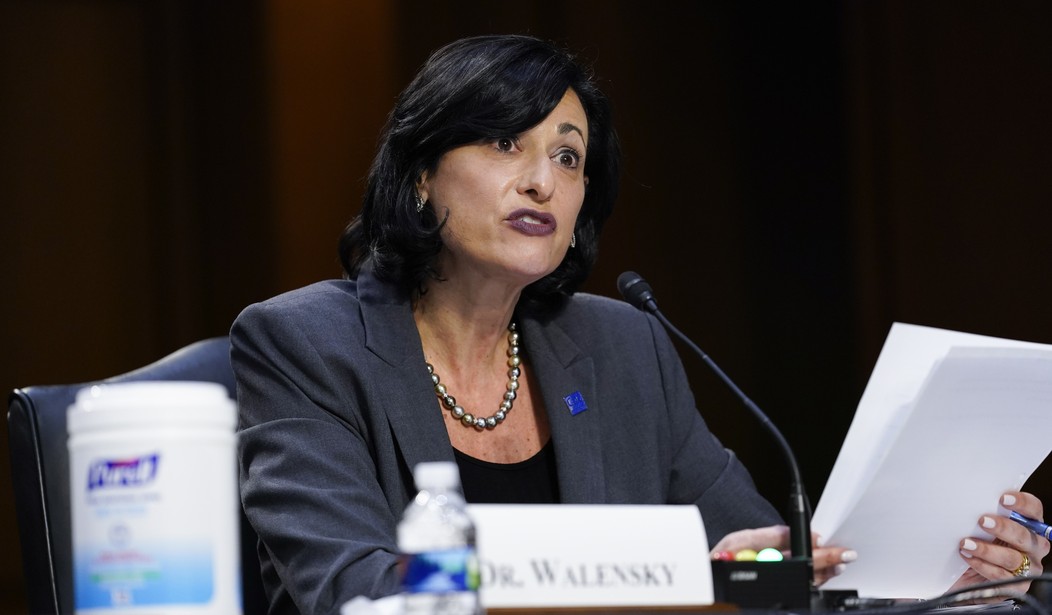What can I say? I enjoy being vindicated. And I would like to thank Centers for Disease Control (CDC) Director Rachel Walensky for making me feel as if I am. Earlier this week, I wrote about a study that demonstrated that prepositions matter when discussing hospitalizations for COVID-19 among children. There is a difference between getting hospitalized with COVID-19 and getting hospitalized for COVID-19 in the hospitals studied. Reported data does not capture this crucial distinction, which likely applies to hospitalizations of children and adults nationwide, given the testing protocols and reimbursement incentives.
I have been railing against the context-less reporting of death counts since the beginning of the pandemic. While writing for another outlet, I noted the bizarre instructions issued by the National Center for Health Statistics after CNN reporter Jim Acosta called any questioning of the counts a conspiracy theory. If Acosta is attacking an idea, there is almost certainly some truth to it. As testing protocols blossomed to the point where every inpatient received one, and the number of asymptomatic individuals who tested positive for COVID-19 became clear, there was even more reason to question the counts.
Then in December, two Minnesota lawmakers said that deaths in their state could have been inflated by as much as 40%. They reviewed thousands of death certificates, and concluded that something was off:
State Rep. Mary Franson and state Sen. Scott Jensen released a video last week revealing that after reviewing thousands of death certificates in the state, 40% did not have COVID-19 as the underlying cause of death.
“I have other examples where COVID isn’t the underlying cause of death, where we have a fall. Another example is we have a freshwater drowning. We have dementia. We have a stroke and multiorgan failure,” Franson said in the video.
She added that in one case, a person who was ejected from a car was “counted as a COVID death” because the virus was in his system.
Recommended: Why Exactly Are Funeral Homes Falsely Writing ‘COVID-19’ on Death Certificates?
This finding followed a study in New Jersey hospitals that found that almost 90% of patients who had COVID-19 listed as a cause of death had a Do Not Resuscitate Order in place before their hospitalization. From the study:
The significance of DNR status as an independent risk factor for mortality has not been documented previously in COVID19 patients. The present study analyzed data of 1270 patients with COVID-19, who were admitted to our institutions during the peak of the COVID-19 pandemic in New Jersey. DNR patients had higher hazard ratios for risk of death and lower survival outcomes compared to non-DNR patients. The association between DNR status and poor clinical outcomes remained independently significant after adjustment for important clinical factors, including age, gender, COVID-19 symptoms at the time of admission and comorbidities.
So, if your doctor felt your health was poor enough to determine that resuscitating you or using lifesaving treatment would not maintain any quality of life, no matter your age, primary diagnosis, or related symptoms, you were more likely to die with COVID-19 on your chart.
Information like this was never shared with the public by the vaunted experts preferred by the legacy media. That may have led to the wildly inaccurate assessments of personal risk for severe disease from COVID-19 among the public.
This month, the sometimes unintentionally too candid Walensky said something on CNN:
CDC Director Rochelle Walensky, somewhat confusingly, says they are aware of 223 people who have died with covid after being vaccinated.
"Not all of those 223 cases who had covid actually died of covid. They may have had mild disease but died, for example, of a heart attack." pic.twitter.com/KmjbrXnd1k
— Justin Baragona (@justinbaragona) May 16, 2021
You’ll have to forgive Justin for finding this confusing. He works for the Daily Beast. Walensky just said out loud what many of us have been saying all along: Testing positive for COVID-19 in the hospital does not mean you have died from COVID-19, especially when there are perverse financial incentives (increased reimbursement from Medicare and full reimbursement from most major insurers) to include the diagnosis on a deceased patient’s chart.
Recommended: Just How Inflated Are Coronavirus Death Counts, Exactly?
When you look at the CDC’s report as of the end of April, it is explicit:
A total of 10,262 SARS-CoV-2 vaccine breakthrough infections had been reported from 46 U.S. states and territories as of April 30, 2021. Among these cases, 6,446 (63%) occurred in females, and the median patient age was 58 years (interquartile range = 40–74 years). Based on preliminary data, 2,725 (27%) vaccine breakthrough infections were asymptomatic, 995 (10%) patients were known to be hospitalized, and 160 (2%) patients died. Among the 995 hospitalized patients, 289 (29%) were asymptomatic or hospitalized for a reason unrelated to COVID-19. The median age of patients who died was 82 years (interquartile range = 71–89 years); 28 (18%) decedents were asymptomatic or died from a cause unrelated to COVID-19.
Let’s take the rough estimate found in California and Minnesota as 40%. Today, the CDC reports that there were 588,421 COVID-19 deaths in the United States. If 40% of those were hospitalized or died with COVID-19, as some have post-vaccination, the number would be more like 353,053. If, as the New Jersey study found, 89% of these people were near the end of life due to illness or frailty, that would mean there were under 40,000 deaths from COVID-19 that could be considered unexpected or warrant further investigation.
Why is the CDC so scrupulous in tracking post-vaccine deaths from COVID-19? They take pains to delineate those who are hospitalized or die with it, rather than because of it. Obviously, we need accurate data on post-vaccination risks. However, shouldn’t the specific risk of severe disease and death from COVID-19 have been communicated to the public during the pandemic? The frequent legacy media guests did not provide this and very few curious reporters attempted to frame it.
The above are indeed rough estimates. However, if we are ever to get an accurate picture of this pandemic, a deep dive must be done. This recalibration will require hospital chart audits for a statistically significant number of patients who reportedly died of COVID-19 in the tracking. If the estimates from California, Minnesota, and New Jersey are even in the ballpark, this must never happen again. Pandemic planning needs to put controls and data collection systems in place to ensure that it does not.
Recommended: VINDICATED: Study Admits There Is a Difference Between Hospitalization ‘With’ and ‘For’ COVID-19
Early in the pandemic, Imperial College modeler Neil Ferguson told the British Parliament the following:
“We don’t know what the level of excess deaths will be in this epidemic,” Ferguson said. In other words, we don’t know the extent to which COVID-19 will increase annual deaths above the level that otherwise would have been expected. “By the end of the year, what proportion of those people who’ve died from COVID-19 would have died anyhow?” Ferguson asked. “It might be as much as half to two-thirds of the deaths we’re seeing from COVID-19, because it’s affecting people who are either at the end of their lives or in poor health conditions. So I think these considerations are very valid.”
An honest assessment may find this was the only thing Ferguson has ever gotten right.










Join the conversation as a VIP Member